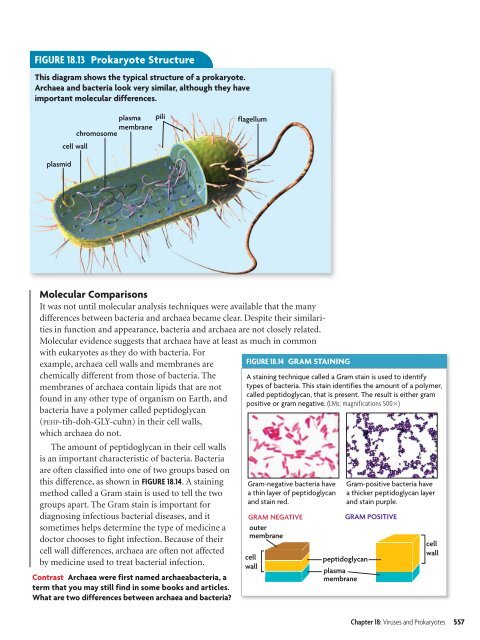18.1 Studying Viruses and Prokaryotes
18.1 Studying Viruses and Prokaryotes
18.1 Studying Viruses and Prokaryotes
You also want an ePaper? Increase the reach of your titles
YUMPU automatically turns print PDFs into web optimized ePapers that Google loves.
FIGURE <strong>18.1</strong>3 Prokaryote StructureThis diagram shows the typical structure of a prokaryote.Archaea <strong>and</strong> bacteria look very similar, although they haveimportant molecular differences.plasma pilimembranechromosomecell wallflagellumplasmidMolecular ComparisonsIt was not until molecular analysis techniques were available that the manydifferences between bacteria <strong>and</strong> archaea became clear. Despite their similaritiesin function <strong>and</strong> appearance, bacteria <strong>and</strong> archaea are not closely related.Molecular evidence suggests that archaea have at least as much in commonwith eukaryotes as they do with bacteria. Forexample, archaea cell walls <strong>and</strong> membranes arechemically different from those of bacteria. Themembranes of archaea contain lipids that are notfound in any other type of organism on Earth, <strong>and</strong>bacteria have a polymer called peptidoglycan(PEHP-tih-doh-GLY-cuhn) in their cell walls,which archaea do not.The amount of peptidoglycan in their cell wallsis an important characteristic of bacteria. Bacteriaare often classified into one of two groups based onthis difference, as shown in FIGURE <strong>18.1</strong>4. A stainingmethod called a Gram stain is used to tell the twogroups apart. The Gram stain is important fordiagnosing infectious bacterial diseases, <strong>and</strong> itsometimes helps determine the type of medicine adoctor chooses to fight infection. Because of theircell wall differences, archaea are often not affectedby medicine used to treat bacterial infection.Contrast Archaea were first named archaeabacteria, aterm that you may still find in some books <strong>and</strong> articles.What are two differences between archaea <strong>and</strong> bacteria?FIGURE <strong>18.1</strong>4 GRAM STAININGA staining technique called a Gram stain is used to identifytypes of bacteria. This stain identifies the amount of a polymer,called peptidoglycan, that is present. The result is either grampositive or gram negative. (LMs; magnifications 500)Gram-negative bacteria havea thin layer of peptidoglycan<strong>and</strong> stain red.GRAM NEGATIVEoutermembranecellwallGram-positive bacteria havea thicker peptidoglycan layer<strong>and</strong> stain purple.peptidoglycanplasmamembraneGRAM POSITIVEcellwallChapter 18: <strong>Viruses</strong> <strong>and</strong> <strong>Prokaryotes</strong> 557
















